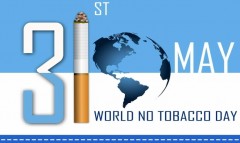31.05.2018
31 may - world no tobacco day is celebrated by WHO

Every year, on May 31, WHO and partners celebrate world no tobacco day, drawing attention to health risks associated with tobacco use and effective policies to reduce tobacco consumption.
The theme of world no tobacco day 2018 is "Tobacco and heart disease". The campaign will aim to raise awareness of the:
links between tobacco and heart disease and other cardiovascular diseases (CVD), including stroke, which together are the leading cause of death in the world;
feasible actions and measures that key stakeholders, including governments and the public can take to reduce tobacco-related health risks heart.
World no tobacco day 2018 is taking place against the backdrop of a number of global initiatives and activities aimed at combating the tobacco epidemic, which has an impact on public health and is the cause of death and suffering of millions of people in the world.
The Ministry of health of the Republic of Belarus is concerned about the problem of tobacco consumption, especially among young people, and takes various measures to prevent this dependence.
Every year, in order to prevent diseases related to tobacco Smoking, and enhance the promotion of healthy lifestyles among the population of the Republic of Belarus, preventive information and educational campaigns are held. Thus, in order to implement the provisions of the WHO framework Convention on tobacco control in the Republic of Belarus, the state program "people's Health and demographic security" for 2016-2020, approved by the Council of Ministers of the Republic of Belarus on March 14, 2016 № 200, as well as in connection with the holding of May 31, 2018 Single health day "world day without tobacco" in the period from 11 to 31 of May in the Republic of Belarus held the Republican anti-tobacco information and education campaign "under the motto" tobacco and heart disease".
The aim of this action is to raise awareness of the population about the relationship between tobacco Smoking and cardiovascular diseases, which are the main cause of death in the world, as well as prevention of tobacco consumption, as one of the important measures to reduce Smoking-related diseases.
Tobacco products are products for which tobacco leaves are used as raw materials and which are intended for Smoking, sucking, chewing or sniffing. The composition of all such products includes nicotine - a psychotropic component that causes severe addiction.
Tobacco use is a major risk factor for a range of chronic diseases, including cancer, lung and cardiovascular diseases. Despite this, tobacco use is widespread throughout the world.
Tobacco Smoking is an epidemic and a global problem for humanity, as exposure to tobacco smoke is one of the causes of death, disease and disability in large numbers of people. The consequences of bad habits annually lead to the death of about 6 million people in the world (600 thousand of them are passive smokers).
In Europe alone, the annual number of tobacco-related deaths is about 1.2 million (14% of all deaths). In Europe, approximately 215 million people are smokers, of which 130 million are men. According to the European Union, 19,000 non-smokers die each year from secondhand smoke. WHO experts predict that by 2020 tobacco will become the main cause of death for 10 million people annually.
Tobacco smoke is harmful not only for a smoker, but also for those who are close to him. Inhalation of air with tobacco smoke is called passive Smoking. There is no safe level of exposure to second-hand smoke.
Studies have shown that the risk of passive Smoking is very real. The smoke flowing from a lit cigarette is unfiltered smoke. It contains 50 times more carcinogens, twice as much tar and nicotine, five times more carbon monoxide and 50 times more ammonia than smoke inhaled through a cigarette. For people who work in a heavily smoked room, the degree of passive Smoking can reach the equivalent of 14 cigarettes smoked per day, which brings them closer to a regular smoker. There is no safe level of exposure to second-hand smoke.
Passive Smoking is dangerous in itself, however, the risks associated with it increase when staying indoors.
Tobacco smoke irritates the upper respiratory tract. Dry nose, sore throat, sneezing-this is only a small, superficial part of the problem. Constant irritation of the nasal mucosa can lead to the formation of vasomotor rhinitis. Not many people know that problems with nasal breathing have a direct connection with ear diseases. Swollen or conversely, overly dry mucosa of the nasal cavity may lead to tubootitis (Eustachio). Asthma in General "loves" passive smokers — they develop it five times more often than those who are lucky not to face tobacco smoke.
Passive Smoking has a powerful effect on the reproductive system, in particular in women — the menstrual cycle becomes shorter than in non-Smoking women. This can cause a decrease in the ability to conceive. Early ovarian depletion is typical of women who smoke, however, passive ovarian syndrome is also not a rare finding.
Smoking when carrying a child to decide, by and large, the woman. And she is also responsible for the development of child complications associated with Smoking. But when a pregnant woman is forced to inhale the smoke of cigarettes of Smoking households — this can already be regarded as intentional harm to her and the child!
Passive Smoking during pregnancy causes such pathological conditions as: high risk of premature birth, low birth weight, increased risk of sudden infant death syndrome, atopic dermatitis in the child.
The eradication of Smoking is one of the effective measures to improve the health of the population.
According to the international cancer Union (UICC), today 30% of all cancer deaths are associated with Smoking. Reducing tobacco use by half will save 170 million lives by 2050.
It is necessary that everyone can breathe air free from tobacco smoke.
Today, there are many methods and ways to get rid of this addiction.
In the Republic of Belarus, assistance to those who have decided to "quit" cigarettes is provided on an outpatient basis in all regional health care institutions that provide drug (psychiatric) assistance to the population. There are 8 specialized rooms for the treatment of nicotine addiction in the Republic. In health facilities where data are lacking, the rooms are functional responsibilities assigned to local doctors-psychiatrists-narcologists, psychotherapists.
Given that the effectiveness of anti-tobacco activities depends largely on the mobilization of all government structures, Belhydromet supports the Republican information and educational campaign. The trade Union Committee of the primary trade Union organization is in constant interaction with the administration of the Belhydromet on the implementation of measures aimed at the formation of a healthy lifestyle, prevention of tobacco use. The trade Union Committee constantly provides organizational and financial support for various sports, sports and tourism activities, monthly subscriptions to the gym and sauna.
Information about the consequences of tobacco consumption and exposure to tobacco smoke is posted on Bulletin boards and in designated Smoking areas and communicated to each employee by mailing your work email, and all employees with this addiction, recommended just for today to stop Smoking.
The activities carried out within the framework of the campaign are one of the opportunities to pay attention to the problem of Smoking, to continue the formation of the team's intolerance to Smoking and prevention of Smoking in public places.
If you are not indifferent to your family and yourself - quit Smoking as soon as possible!















